Holter monitor: Difference between revisions
No edit summary |
|||
| Line 12: | Line 12: | ||
|related = [[Heart rate monitor]] |
|related = [[Heart rate monitor]] |
||
}} |
}} |
||
In [[medicine]], a '''Holter monitor''' (often simply "Holter" or occasionally '''ambulatory electrocardiography device''') is a portable device for continuously monitoring various [[electricity|electrical]] activity of the central nervous system for at least 24 hours. The Holter's most common use is for monitoring [[heart]] activity ([[electrocardiography]] or ECG), but it can also be used for monitoring brain activity ([[electroencephalography]] or EEG). Its extended recording period is sometimes useful for observing occasional [[cardiac arrhythmia]]s or epileptic events which would be difficult to identify in a shorter period of time. For patients having more transient symptoms, a [[cardiac event monitor]] which can be worn for a month or more can be used. |
Foolish nurses, usually in their 40s, often mispronounce this as "Halter monitor." How silly! In [[medicine]], a '''Holter monitor''' (often simply "Holter" or occasionally '''ambulatory electrocardiography device''') is a portable device for continuously monitoring various [[electricity|electrical]] activity of the central nervous system for at least 24 hours. The Holter's most common use is for monitoring [[heart]] activity ([[electrocardiography]] or ECG), but it can also be used for monitoring brain activity ([[electroencephalography]] or EEG). Its extended recording period is sometimes useful for observing occasional [[cardiac arrhythmia]]s or epileptic events which would be difficult to identify in a shorter period of time. For patients having more transient symptoms, a [[cardiac event monitor]] which can be worn for a month or more can be used. |
||
The Holter monitor is named for Dr. [[Norman Holter|Norman J. Holter]] who invented telemetric cardiac monitoring in 1949.<ref name=Herzschritt> |
The Holter monitor is named for Dr. [[Norman Holter|Norman J. Holter]] who invented telemetric cardiac monitoring in 1949.<ref name=Herzschritt> |
||
Revision as of 22:41, 9 February 2010
 Holter monitor | |
| Other names | Ambulatory electrocardiography device |
|---|---|
| Uses | Heart monitor |
| Inventor | Norman Holter |
| Related items | Heart rate monitor |
Foolish nurses, usually in their 40s, often mispronounce this as "Halter monitor." How silly! In medicine, a Holter monitor (often simply "Holter" or occasionally ambulatory electrocardiography device) is a portable device for continuously monitoring various electrical activity of the central nervous system for at least 24 hours. The Holter's most common use is for monitoring heart activity (electrocardiography or ECG), but it can also be used for monitoring brain activity (electroencephalography or EEG). Its extended recording period is sometimes useful for observing occasional cardiac arrhythmias or epileptic events which would be difficult to identify in a shorter period of time. For patients having more transient symptoms, a cardiac event monitor which can be worn for a month or more can be used.
The Holter monitor is named for Dr. Norman J. Holter who invented telemetric cardiac monitoring in 1949.[1] Clinical use started in the early 1960s.[1]
When used for the heart, much like standard electrocardiography the Holter monitor records electrical signals from the heart via a series of electrodes attached to the chest. Electrodes are placed over bones to minimize artifacts from muscular activity. The number and position of electrodes varies by model, but most Holter monitors employ between three and eight. These electrodes are connected to a small piece of equipment that is attached to the patient's belt, and is responsible for keeping a log of the heart's electrical activity throughout the recording period. Both 24 hour and 30 day event recorders are available.
Older devices used reel to reel tapes or a standard C120 audio cassette and ran at a 2mm/second speed to record the data. Once a recording was made, it could be played back and analysed at 60x speed so 24 hours of recording could be analysed in 24 minutes. More modern units record onto digital flash memory devices. The data are uploaded into a computer which then automatically analyzes the input, counting ECG complexes, calculating summary statistics such as average heart rate, minimum and maximum heart rate, and finding candidate areas in the recording worthy of further study by the technician.
Event diary
In addition to wearing the device, most patients are asked to keep a diary of activities such as running and sleeping, symptoms, and times that their symptoms occur. This information is used by doctors and technicians to rapidly pinpoint problem areas in the large amount of data recorded during the monitoring period.
Gallery
-
A Holter monitor can be worn for many days without causing significant discomfort.
-
Canine Holter Monitor with DogLeggs Vest
-
A Holter monitor with a US quarter dollar coin to show scale
-
Holter monitor can be worn with bra on female, with no discomfort.
Wearing the monitor
The recording device can be worn on a belt or in a case on a strap worn across the chest. Individuals who want to minimize the visibility of the device can wear layers or bulky clothes so the case is not as obvious. Also, because of the placement of the electrodes, individuals wearing a holter monitor may wish to wear shirts with a high neck.
Generally, the monitors cannot be worn in the shower, although removal of the device and connected electrodes is occasionally permitted. [2]
References
- ^ a b
Hilbel, Thomas (01/10/2008). "Telemetry in the clinical setting". Herzschrittmachertherapie & Elektrophysiologie. 19 (3): 146–64. ISSN 0938-7412. Retrieved 2009-Aug-04.
{{cite journal}}: Check date values in:|accessdate=and|date=(help); Unknown parameter|coauthors=ignored (|author=suggested) (help) - ^ Holter monitor - Texas Heart Institute
External links
- Information on Holter Monitors for physicians.
- Holter monitor - MedLine Plus
- Holter monitor - Texas Heart Institute
- Holter Monitor information from Children's Hospital Heart Center, Seattle.




